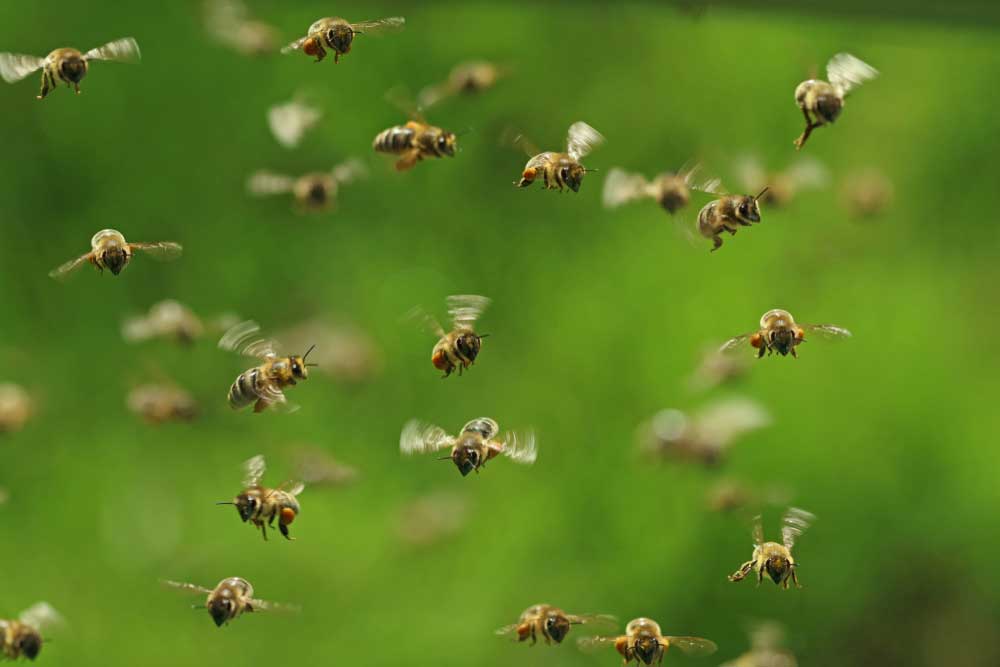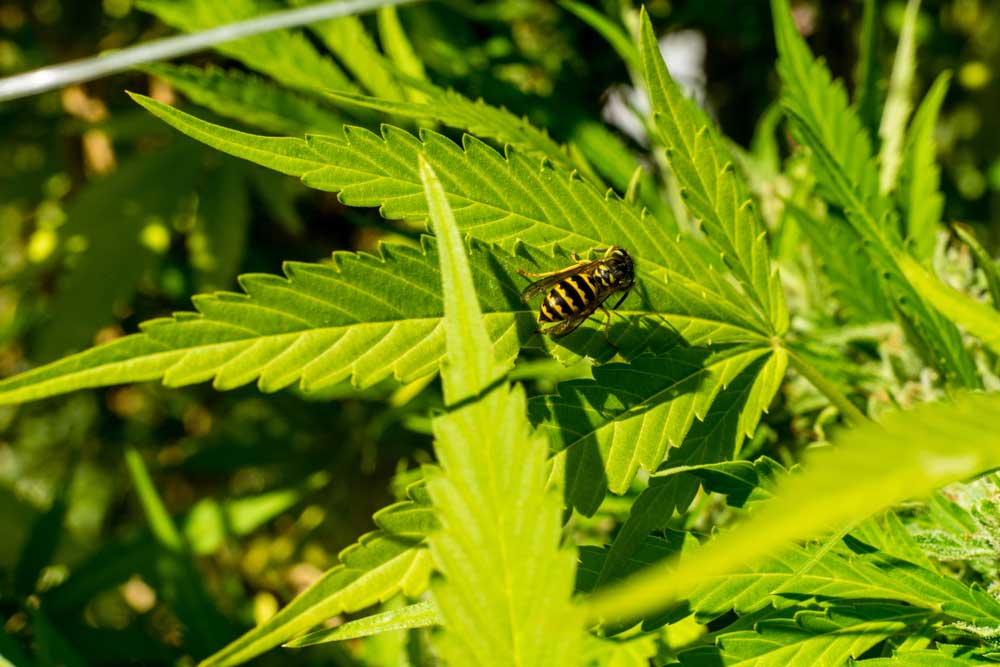Contents [ Hide ]

When we think about bees we think of two things, getting stung and making honey. For the most of us this is as far as our knowledge goes when it comes to bees, but what many don’t know is that bees provide essential functions to our environment, contributing to the existence of humans, animals and plants. It also turns out that bees are attracted to a familiar plant that humans can’t get enough of… cannabis. For us humans, we love the psychoactive and medicinal benefits cannabis has to offer, from getting rid of the stress in our life to reducing pain and inflammation, the cannabis plant is a powerful tool that we are only beginning to understand the potential of. A perfect example of its untapped potential is its surprise relationship with bees. The bees of the world aren’t after a hit your MK Ultra plant to catch a buzz, they are extremely attracted to the cannabis plant for its sweet pollen. This is an important discovery in the constant battle to keep the bee population thriving. The number of bees in the world is rapidly becoming depleted largely due to pesticides, habitat loss and climate change. Bees and their ability to spread pollination are a major factor in the global food chain and with their rapidly declining numbers it is imperative steps are taking to help revitalize their population. This new connection between bees and cannabis can play a huge role in the restoration and prosperity of bee population on earth.

What is Happening To The Bees

Bees are some of the oldest species on our earth, dating back over 100-million years ago. They arguably do the most thankless job and get very little credit. It hasn’t been until the last decade that people are starting to understand the importance of bees and how they need to be protected at all costs. Bees number one job for the planet is to pollinate, these pollinators work with the likes of ants, bats, moths, birds and butterflies to spread pollen over crops and plants throughout the world. Bees however are the superstars and most fragile when it comes to insects that spread pollen. Scientists attribute the pollination of bees to one out of every three bites of food the average person eats. Food groups such as apples, almonds, avocados, blueberries, cherries, cucumbers, onions, grapefruit, orange and pumpkins would be impossible to grow without the pollination spread from bees. Almonds are a perfect example with every acre of almonds requiring around two hives just to survive and grow. Bees also have a major contribution to the global economy, with bees pollinating crops upwards to around 14 billion dollars annually.
Unfortunately though the insects that were named the world’s most invaluable species are in a rate of rapid decline, so why are bees disappearing?
One term that has been commonly coined is colony collapse disorder (CCD) which is the sudden and unexplained decline of a single or group of hives. The phenomenon occurs when the worker bees of the colony disappear leaving behind the queen, food and nurse bees. Between 2007-2013 over 10 million bee colonies across the world were lost to CCD. There are several possible reasons CCD occurs but a specific option cannot be decide among the scientific world. There are a few suggestions that indicate what is causing this rapid decrease in bee population:
Loss of habitat
Bees are flat out running out of real estate, the wildflowers bees use to get their pollen are diminishing. Fields of flowers are now either filled with harmful pesticides that kill the bees, or have been wiped out due to growing industrial development that is diminishing the land the flowers once grew in.
Climate Change
As the climate warms up in temperature it can directly influence the behaviour of the bees and how they hibernate. With the drastic weather fluctuations taking place over the last few years bees sometimes think it is time to stop their hibernations and head back to work. This leads many bees to leave their hive, not returning in time when the warm snap breaks. The queen then becomes vulnerable during the cold months because her workers aren’t there to protect and keep her warm. If the queen dies then the colony leaves in search for a new leader, at times never finding one.
Varroa Mites
These mites are arguably the biggest problem when it comes to the decline of bees over the last 20 years. Varroa Mites are known to feed on bees blood vessels, along with their larvae. This leads to the bees lifespans being weakened and shortened and their newborn are born with defects. The spread of varroa mites within a colony can be detrimental to its survival.
Pesticides
Pesticides are commonly used among growers of plants and crops to protect against invasive insects. Recently a pesticide known as neonicotinoids is being used and it is known to affect bees nervous systems making it hard for them to fly straight. This pesticide is used around the world and is one of the most commonly used insecticides. Until growers alter their usage of certain pesticides then bees will continue to be effected.
Can Cannabis Help Restore The Bee Population?

Bees are generally attracted to flowers that are rich in both nectar and pollen, this is why it has come to some surprise that recent research suggests bees love cannabis plants and that their relationship has great potential to help with their declining population. Bees typically are attracted to plants that offer sweet, sugary nectar that come from floral plants whose intention is to attract insets to promote pollination. So it comes to a surprise to many that bees have become attracted to various cannabis plants as it is a wind pollinated plant that has no need for nectar to draw insect pollinators. However with many floral flowers dyeing off the cannabis plant has become an important source of pollen. Let’s take a look at several studies that have shown bees and cannabis are meant to bee together.
A study directly out of Colorado State University Graduate School looked at the coloration between bees and cannabis flowers, specifically the hemp plant. The study was conducted by entomology student Colton O’Brien who observed swarms of bees in the university’s hemp field which was an uncommon trait considering hemp is wind pollinated and bees have no influence in the hemp plants pollination process. The study collected samples directly from the bees who were collecting pollen during the hemps full bloom with the hope of discovering what types of bees were collecting the pollen. Out of the 66 species of bees located in Colorado, 23 were found to be using the hemp field for collecting pollen, with around 2000 bees in total located in the hemp field. They old discovered that is wasn’t just the bees who were benefiting from the hemp pollen, the parasites of specific bees were also benefiting as well. These parasites weren’t utilizing the pollen that was taken directly from the hemp flower but they were utilizing the pollen that was eventually brought back by the bees. This helped the study conclude that the hemp fields were creating a dynamic ecosystem for bees that wouldn’t be available without the hemp plant. The study shows a direct correlation between the hemp plant helping with the declining bee population, indicating that the hemp plant is a ecologically valuable crop of flowers that has the ability to attract and produce an abundance of pollen for a variety of bee species. This is especially encouraging as floral flowers are dyeing off and hemp plants are becoming more commonly grown to the demand in such things as CBD.
Another study this time out of Cornell University published in the Environmental Entomology also showed a positive relationship between bees and the marijuana plants. During the study researches collected bees who were visiting hemp flower on 11 separate farms throughout the Finger Lakes region of New York State. This is research they found that 16 different species of bees were visiting these hemp farms. One of the most interesting findings was that the specific height of a hemp plant directly correlated with the type of bee who visited the plan and the total number of bees, with the taller plants attracting a wider diversity of bee species. In comparison to the shorter plants, the taller plants produced a larger amount of pollen and were more apparent to the bees, this lead to 17 times the number of visits to taller plants. Similar to the study out of Colorado State, the blooming period of the hemp plant saw the strongest number of bees visiting the plants. The study concluded that the hemp plant as a potential to provide a strong nutritional outlet for bees during their time of decline and can help increase the spread of pollination for other crops that rely heavily on bees.
Both studies also concluded that because the cannabis plant is a late-season crop when it comes to flowering that it is a great pollen provider during the end of the flowering season when pollen is scarce for bees. During this period of seasons floral dearth, hemp has a great potential to increase pollination for crops in the following year as well. This was shown in a study conducted out of Punjab, India, where during the floral dearth period bees turned to the male cannabis plants that grow in the wild in that region as a pollen source. Those bees superficially were fed on the plants pollen as the cannabis flower does not produce any nectar and were only observed feeding on male flowers only during the morning and evening. This was due to what is known as the anther dehiscence which is where the male reproductive organs of a cannabis plant split to release pollen during the morning and evening. Concluding that bees are only attracted to male cannabis plants, only during the floral dearth periods and only during the peak pollination periods during the day.
As the bee population decreases this new revelation of bees and marijuana and their thriving relationship is a welcome surprise to those closely concerned with the bee population. Bees and marijuana plants can help increase the population of bees and unlike other flowers that are dealing with their own decline due to environmental concerns cannabis plants are constantly being planted and grown throughout the world.
Haute Health
Buying weed online in Canada has never been easier with Haute Health, our catalog of cannabis products offers a wide selection tasty treats that will satisfy any cannabis lovers needs. Whether you need to buy hash online, cannabis concentrates or cannabis edibles online, we have the best weed deals online anywhere on the web.
